What’s bigger than a gorilla but smaller than a submarine? The world’s largest halibut, was caught by Macro Liebenow when he joked about hooking one of the underwater boats. When the halibut was hooked and dragged in with some mighty strength, a 90-minute fight, and the help of three friends, it weighed 513 pounds.
The Biggest Halibut in History
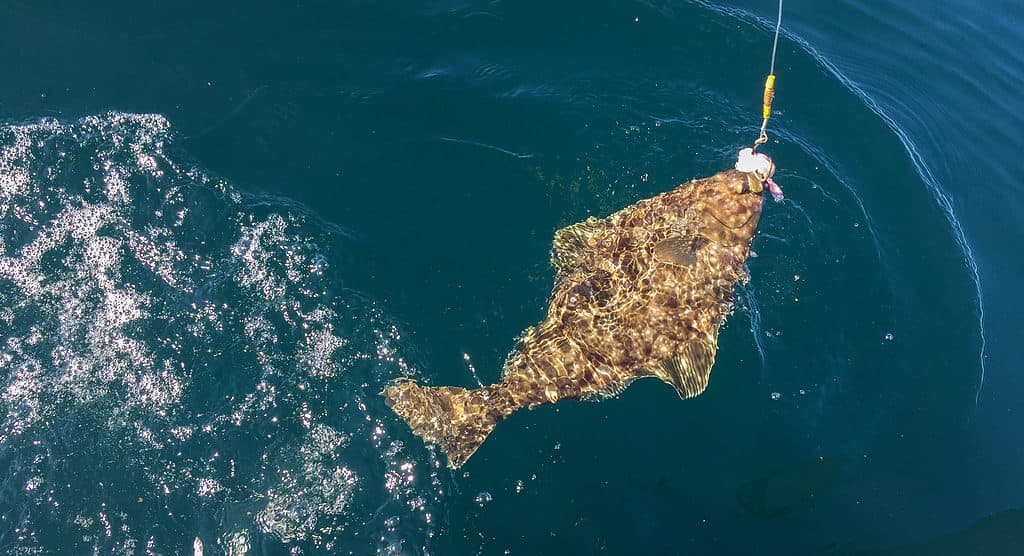
Halibut, on average, weighs between 40 and 440 pounds, depending on the species.
©Jon C. Beverly/Shutterstock.com
Before the German fisherman and his companions, fishing in Norwegian waters off Kjollefjord, hauled in the beast of a fish, the largest halibut on record was a 419-pound Atlantic halibut caught in 2004. Then, in 2019, Liebenow’s halibut, measuring 8.6 feet in length, took the record easily away from the former. The fish was so large, in fact, that the group wouldn’t bring the fish into the boat. Instead, they secured the monster fish with rope and towed the beast back to land. A crane has to be engaged to hoist the fish ashore.
If you think it’s an exaggeration to say the fish weighs more than an ape, you’ll be surprised. The average weight of a western lowland gorilla is between 300 and 500 pounds. So, though it’s a close call, the monster fish still beats out the huge ape.
Where Is Kjollefjord Located on a Map?
Kjollefjord is a Norwegian village located on the Nordkinn Peninsula, on the shore of a small fjord that provides shelter from the open sea. Because of this protection, it has been a haven for seafarers and a marketplace since the 1500s. It has numerous festivals and concerts each year.
Largest Pacific Halibut
The official record for the largest Pacific halibut is that of a 459-pound fish, caught by Jack Tragis in 1996, in Dutch Harbor, Alaska.
Of course, every year, unofficial (i.e., not sanctioned) halibuts are caught and so are believed to have broken some of the past records. In fact, the biggest estimated halibut was caught in Alaska, weighing in at 533 pounds. The commercial catch, however, was not permitted as a record-maker because of regulations surrounding the various organizations that keep these records. Other reports claim halibut at over 600 pounds have been caught (Atlantic halibut). This makes fully answering the question of which has been the largest technically complicated. But, going with official records, Liebenow’s record seems to stand.
Overview of Halibuts
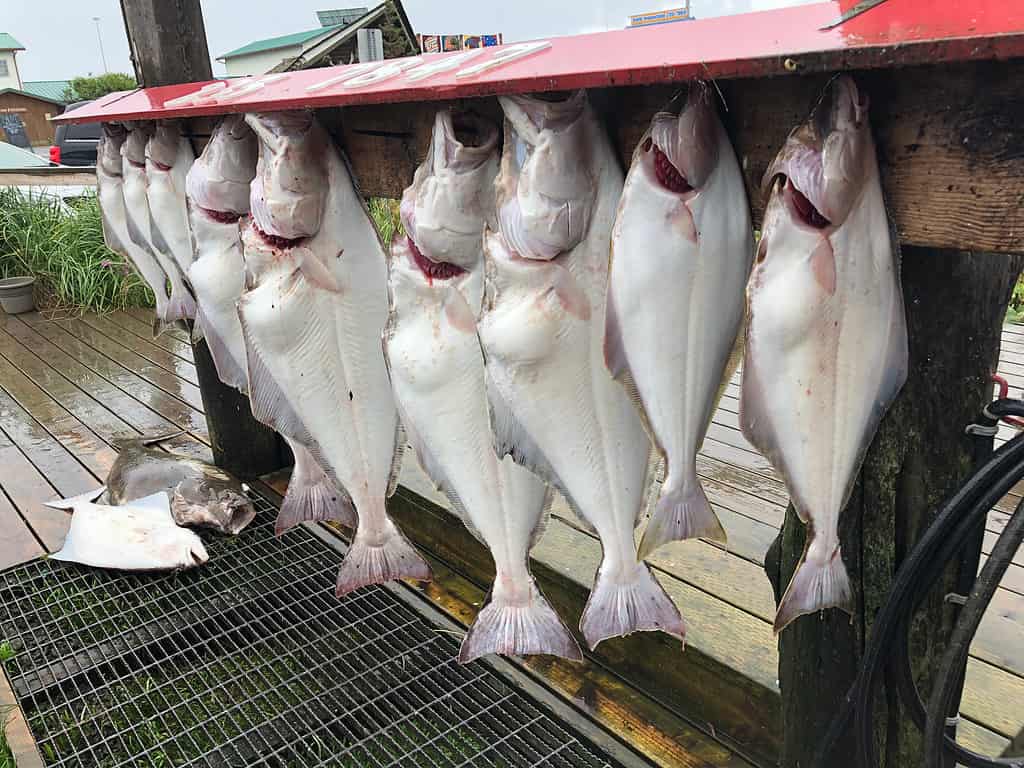
Most halibut are significantly smaller than the record-setters.
©melissamn/Shutterstock.com
Most halibut that are caught and brought in weigh between 50 and 150 pounds. This applies to either Pacific halibut or Atlantic halibut. Obviously, some weigh far more than this, outweighing humans significantly.
The species is a flat fish, sometimes confused with flounder by some, and is highly prized by fishers for their fight, and chefs for their flavor. Pacific halibut are known scientifically as Hippoglossus stenolepsis and the Atlantic halibut is known as the Hippoglossus hippoglossus. Larger specimens have been given the nickname “barn doors” for their sheer size, while the smaller halibuts are known as “chickens.”
What Happened to the Biggest Halibut?
It’s reported that Liebenow had his fish weighed and then donated it to a local fish dealer. Then, of course, he celebrated his record catch with a few beers with his friends.
How the Heck Would a Halibut Get So Big?
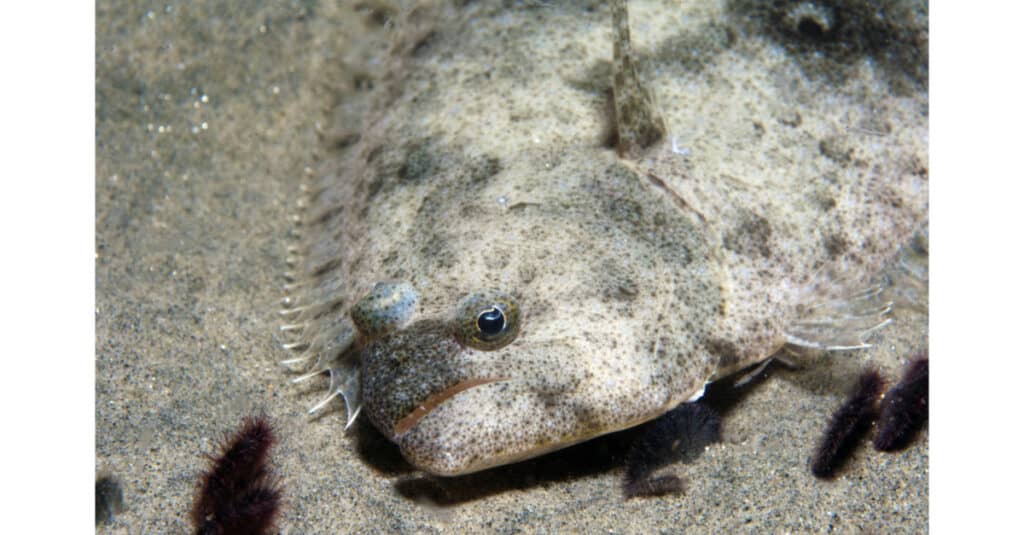
Halibuts are flat fish with right-facing eyes
©205868233/Shutterstock.com
It’s projected that the largest halibut may well reach beyond the record size of 513 pounds. Suspicions lead to halibut weighing in at as high as 700 pounds. That’s freaking huge! So, how do these monster fish come to be when other flatfish aren’t nearly as large?
Among some of the largest bony fish in the world, halibuts have a few other advantages that may help them achieve these incredible sizes.
How Big Do Halibut Get?
It is believed that halibut may reach up to 15 feet in length and at least 700 pounds, though no living specimens have been caught at this size and officially confirmed.
Habitat Range and Diet
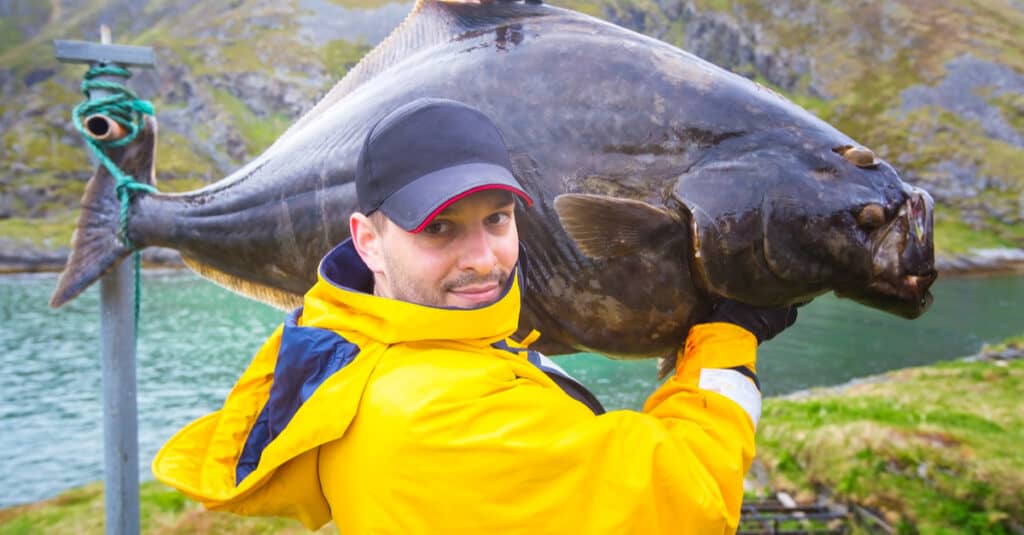
Being careful to not overfish for halibut is an important factor in helping these fish get so big.
©Alexey Savchuk/Shutterstock.com
One factor that experts believe impacts the size of these humongous fish is the range of their habitat. The massive bony fish range from the Bering Sea into Central California, from Greenland to the Bay of Biscay, depending on their species. They live as deep as 300 to 1,500 feet in the water, meaning their range takes place along the continental shelf.
This range provides halibut with a huge variety of fish and other animals that they may eat, which helps them achieve this massive size. Halibut are known to eat:
- Cod
- Turbot
- Pollock
- Octopus
- Crab
- Shrimp
And if they leave the ocean floor, which they do on occasion, they may do so specifically to add some dietary variety. In these cases, they’ll eat sand lance, herring, salmon, and even seals, when the halibut is large enough to catch one.
Age
Additionally, halibut have an unusually long lifespan for this type of fish. They’ve been known to live to at least 50 years of age, and some that have escaped capture are likely to have lived even longer. Because of their lengthy lifespan, these fish have the opportunity to keep growing, which enables them to reach these massive sizes.
Predation is Less Common
Finally, because of the sheer size of the fish, halibuts have few predators that can actually catch and kill them. Which, in turn, allows them to live longer and ultimately grow larger.
The fish are slow growing, it should be noted, so many halibuts that are caught are much, much smaller. Most halibut that humans catch rarely are longer than about 8 feet, with many averaging closer to 4 or 5 feet in length. Male halibuts also rarely reach even 100 pounds, while the females are the fish that hit up to five times that size (meaning most record-setters are females).
As slow-growing fish, they may well be caught easily by fishers and predators. Once they reach a certain size, however, capture is far less likely.
Threats or Risks for Halibut
Currently, there is not a great deal of concern over Pacific halibut. Abundant, healthy populations have been noted overall for the species. However, Atlantic Halibut in the waters off the U.S. and Canada have been listed as endangered by the IUCN (International Union for Conservation of Nature). No directed commercial fishery exists for Atlantic halibut in the U.S., though bycatch of halibut does occur in fisheries.
Consistent threats from warming waters, pollution, bycatch, and overfishing are near at hand and always concerning to conservationists. Fishery managements have been in place since 1923, but these have limits, as seen in the decline of Atlantic halibut population. A catch limit has been placed (since 1923) to help prevent overfishing, but, again, other threats remain to the habitats and therefore potential populations of the huge fish.
Intriguing Facts About Halibut
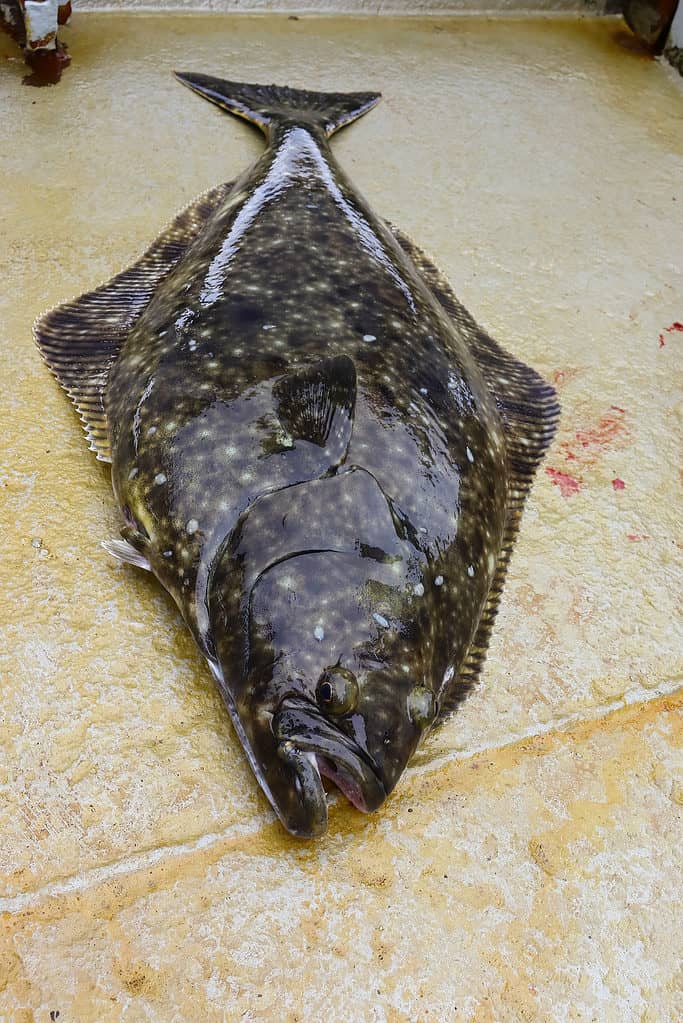
You can see the migration of the eyes in this halibut, with one much more “on top” than the other.
©Nick Kashenko/Shutterstock.com
- The flat fish are born with one eye on each side of their bodies. However, as they mature, their eyes shift and come closer together on just one side of their bodies.
- If both of the eyes of a halibut are on this fish’s left side, it is considered a “righteyed” halibut.
- Roughly 1 in 20,000 halibut will have its eyes migrate to the bottom instead of the top of the fish. These are the ones known as “left-eyed” halibut.
- Determining the age of a halibut is done by counting the rings in the ear bone (otolith) of the fish.
- The largest species of flatfish in the world is the Pacific halibut.
- Because they belong to the righteye flounder family (without being flounder), halibut are often confused with the arrowtooth flounder.
- Halibut have two colors: brown on top and white on the bottom.
- Female halibuts produce eggs in correlation to their size. The larger the female, the more eggs she will produce. For example: a 250-pound halibut will lay 4 million eggs every year. A 50-pound female will lay about half a million eggs annually.
- If you catch a halibut that weighs more than 90 to 100 pounds, it’s almost guaranteed to be a female.
Thank you for reading! Have some feedback for us? Contact the AZ Animals editorial team.








